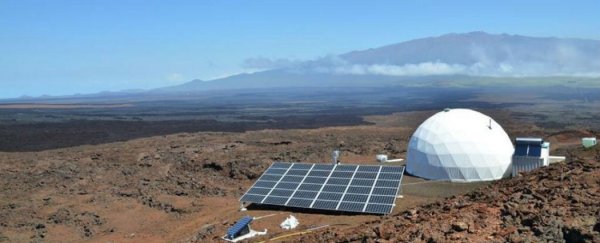Six NASA recruits have begun a year-long isolation experiment to simulate the experience of what life would be like for our first Mars settlers. They filed into a dome on the northern slope of the Mauna Loa volcano in Hawaii on Friday afternoon, where they'll live in close quarters without fresh food, fresh air, zero privacy, and no physical contact with the outside world whatsoever.
Called the HI-SEAS IV, the experiment will be the longest mission ever attempted to simulate a long-haul manned space flight. While NASA has previously conducted four-month and eight-month-long isolation experiments, it's been estimated that humans will take between one and three years to fly to Mars, so to get some kind of idea of what the first colonists will have to go through, they'll need to make it for at least 12 months in this tiny dome, which is just 11 metres (36 feet) in diameter and 6 metres (20 feet) tall.
According to the BBC, the six recruits (three men, three women) include four Americans - a pilot, an architect, a journalist and a soil scientist - a French astrobiologist, and a German physicist. They will need to keep their spacesuits on at all times to simulate life on a spaceship, and will each be given a sleeping cot and a desk in their shared rooms.
Once a week, the crew will be allowed to stretch their legs outside to conduct experiments - like they'd be doing outside the spaceship on an actual Mars trip - and they'll be allowed to communicate with mission control, their families, and the public electronically, but will have to schedule it with a delay to simulate how long it would take a message to travel from Mars to Earth.
The experiment is as much about how the recruits will individually cope with the lack of privacy, living off supplies like tuna and powdered cheese, and spending time away when their loved ones, as it is about observing how they get along as a group in such a small space. Researchers from the University of Hawaii Manoa will be monitoring their progress for the next 12 months.
"I think one of the lessons is that you really can't prevent interpersonal conflicts. It is going to happen over these long-duration missions, even with the very best people," HI-SEAS chief investigator Kim Binsted told the AFP. "But what you can do is help people be resilient, so, they respond well to the problems and can resolve them and continue to perform well as a team."
We wish them the best of luck! You can follow the crew members on Twitter, here are a couple of the first tweets:
First dinner in simulated space: the cheese & turkey quesadilla & all the veggies were all dehydrated 30 min ago. pic.twitter.com/LX91nUT29v
— Sheyna Gifford, masked, vaccinated, doctoring (@humansareawesme) August 29, 2015
MD0: Our first Martian sunset. @HI_SEAS @humansareawesme @CyprienVerseux pic.twitter.com/QV5Ea9y24Q
— Andrzej Stewart (@HISEAS_Andrzej) August 29, 2015
